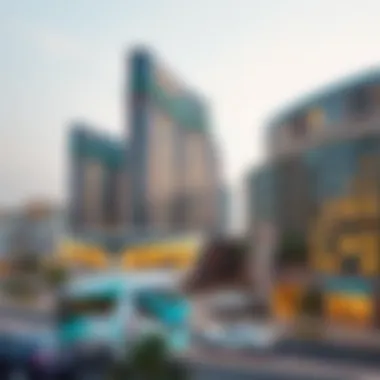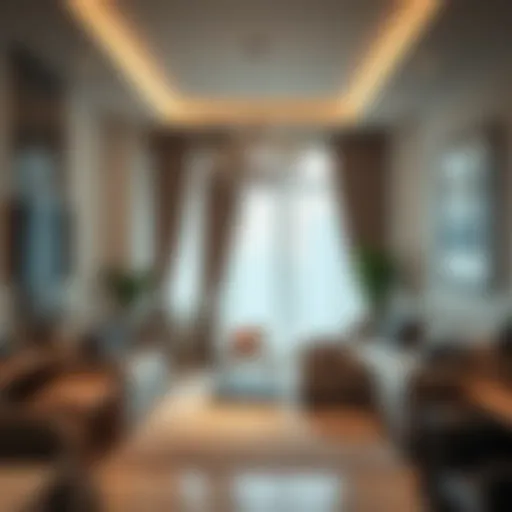Emaar Developments: Shaping Dubai's Real Estate Future


Intro
Emaar Developments stands as a towering presence in the realm of Dubai's real estate market, acting not just as a developer, but as a pivotal force in reshaping the urban landscape. From the iconic Burj Khalifa to the expansive Dubai Mall, Emaar’s projects have been synonymous with luxury and innovation, captaining projects that have garnered international attention and set benchmarks for excellence.
This article aims to traverse the multifaceted narrative of Emaar Developments, exploring its historical evolution, notable projects, and future trajectories within the competitive real estate market. With the continued growth of UAE's property sector, understanding Emaar’s strategies offers invaluable insights for investors, homebuyers, and real estate agents alike.
Market Trends in Dubai Real Estate
Current Market Overview
The Dubai real estate market has transitioned significantly over the past few years. According to the Dubai Land Department, property transactions reached record levels in recent times, with numerous new projects entering the mix. Various factors contribute to this vibrant market, including a continually growing expat community, burgeoning tourism, and sustained infrastructure developments spurred by events like Expo 2020.
Emaar, being a trailblazer, has effectively navigated these trends, expanding its portfolio and often leading the charge in innovating new residential and commercial spaces. The appeal of Dubai as a cosmopolitan hub attracts domestic and international investors alike, thereby fostering a competitive yet rewarding marketplace.
Price Trends and Forecasts
The price trajectory in Dubai’s real estate often reflects broader economic conditions, and the current trend boasts a blend of stability and gradual upward movement. Market analysts predict that prime areas spearheaded by Emaar developments will remain lucrative. The price per square foot in communities like Dubai Marina and Downtown Dubai has witnessed a steady increase, signifying a robust demand.
Looking forward, experts anticipate that as Emaar continues to launch new projects and promote sustainability, prices are likely to climb further due to a mix of high demand and an influx of international investors. This makes it critical for those involved in real estate to stay attuned to these shifts, particularly for homeowners and investors aiming to make informed decisions.
"Emaar Developments' focus on integrating technology and sustainability in its projects could very well be the catalyst that drives prices higher in the coming years."
Investment Opportunities
Hot Areas for Investment
When it comes to identifying hot spots for investment, Emaar's projects often top the list. Areas such as Dubai Hills Estate and Arabian Ranches have generated considerable buzz. These locations are characterized by their high-quality amenities, diverse housing options, and proximity to major roadways and business districts.
Investors should especially consider:
- Dubai Hills Estate: This community embodies an upscale living environment, appealing not just to families but also to young professionals seeking modern housing.
- Arabian Ranches: Known for its villas and family-oriented infrastructure, this area presents a tranquil lifestyle while still being part of the larger economic fabric of Dubai.
Rental Yield Analysis
Understanding rental yields can provide another layer of insight into the investment landscape. Typically, properties developed by Emaar maintain a strong rental demand due to their location and quality.
The average rental yields in popular Emaar developments hover around 6-8%, which is competitive by many standards globally. These numbers indicate that the investments are not just robust in terms of value appreciation but also offer excellent return potential through rental income.
For those considering entering the market, it’s advisable to conduct thorough research on specific areas, evaluate property management options, and, if possible, connect with locals to gain a nuanced understanding of the market dynamics.
Preamble to Emaar Developments
In the realm of Dubai's rapidly evolving real estate market, Emaar Developments stands as a monumental force. Founded in the late 1990s, the company has revolutionized the skyline and lifestyle of the emirate, making it a pivotal player in urban development. Investors, homebuyers, and real estate professionals alike find great significance in understanding this industry titan.
Emaar’s influence extends beyond constructing buildings; it shapes communities and drives economic prosperity. This introduction sheds light on several key aspects of Emaar: its commitment to innovative design, the integration of sustainable practices, and its role in cultural and social development. The essence of Emaar lies in its customer-oriented approach, which prioritizes the needs of residents while balancing economic goals.
By examining Emaar Developments, one gains insights into:
- The impact of luxury residential projects on Dubai's real estate landscape.
- How commercial properties contribute to the economic fabric of the region.
- The embrace of mixed-use developments, fostering vibrant communities.
- The integration of technology in creating smart living solutions.
A discerning audience will further appreciate the importance of Emaar in discussing how it addresses contemporary challenges, including sustainability and community enrichment. Moreover, being aware of Emaar's trajectory provides valuable information to those looking to invest wisely or find their dream home in one of the world's most dynamic cities.
"Emaar Developments is not just about selling properties; it’s about creating legacies that endure through generations."
Engaging with Emaar means not just learning about a company but becoming part of a story that continues to shape global standards in architecture and urban living. With this in mind, let's delve deeper into the historical background of Emaar Developments to understand how it has reached its current standing.
Historical Background
Understanding the historical context of Emaar Developments gives valuable insights into its formidable rise in the real estate sector. Knowing where a company has come from often foreshadows its trajectory and capabilities, making this section particularly relevant for investors and homebuyers eager to comprehend the company’s foundational elements and significant milestones. Emaar's journey is not just about numbers or property but about vision and strategy that shaped a vibrant part of Dubai’s urban landscape.
Foundation and Growth
Emaar Developments was established in 1997 through the visionary impetus of Mohammed Alabbar. This move wasn't an arbitrary decision; it was rooted in a larger context of transforming Dubai into a global hub. At that time, the UAE was beginning to pivot toward a future defined by commerce and tourism, and Emaar was a crucial player in that aspiration.
In its initial years, Emaar honed in on developing residential properties that catered to the nascent middle-class population and the influx of expatriates looking for accommodation. The ability to read the market trends allowed the company to grow rapidly, establishing a robust brand that resonated with quality construction and innovative design. Emaar’s commitment to excellence ensured that its early projects, such as the Emirates Hills and The Meadows, not only sold well but also became icons of the luxury residential landscape.
The growth trajectory witnessed a steep ascent with the development of signature projects like Burj Khalifa, the world’s tallest building, which was inaugurated in 2010. Such monumental achievements signified Emaar's relentless pursuit of pushing boundaries in real estate and marked its evolution from a local enterprise to a globally recognized brand. Key partnerships and investments were often leveraged to fuel further expansion, capitalizing on emerging opportunities within and beyond the Dubai market.
Key Milestones
Emaar's history is punctuated with notable milestones that reflect its ambition and strategic prowess:
- IPO Launch in 2000: This marked a significant shift, tapping into public investment and fostering a broad shareholder base. The IPO was a game-changer, allowing for accelerated projects and expansions.
- The Borderless Expansion (2005): Finding a niche in international markets, Emaar began to extend its footprint beyond Dubai to countries like Egypt and Saudi Arabia. This diversification bolstered its portfolio and reduced risk exposure.
- Completion of Burj Khalifa (2010): This iconic structure not only symbolized Emaar's architectural bravado but also put Dubai on the world map as a tourist destination, creating a win-win situation for stakeholders.
- Entering into Retail with Emaar Malls (2014): Understanding the importance of mixed-use developments, Emaar created Emaar Malls as a subsidiary. This move recognized the rising demand for integrated living spaces.
- Commitment to Sustainability (2016): Emaar's announcement to invest in sustainable building technologies illustrated its commitment to responsible development, addressing growing environmental concerns among investors and citizens alike.
These milestones offer a rich narrative of resilience, foresight, and strategic decision-making, hallmark traits that define Emaar. As the company moves forward, the essence of its historical context will undoubtedly play a vital role in shaping its ongoing and future developments.
"History is not a burden on the memory but an illumination of the spirit." - John Edwin McGowan
For further reading and background on real estate development trends, you might visit Britannica. Also, consider exploring Emaar's website for the latest updates and projects.
Major Developments
Emaar Developments stands out as a cornerstone in Dubai's rapidly evolving real estate landscape. This section delves into the company’s pivotal projects that not only showcase their architectural prowess but also highlight their commitment to innovation and community integration. Understanding these developments is crucial for investors, homebuyers, and real estate professionals, as they reflect current trends and future potential in the market.


Luxury Residential Projects
Emaar has carved a niche in the luxury residential segment, setting benchmarks that many strive to achieve. Projects like Burj Khalifa, the tallest building in the world, epitomize luxury living with an array of high-end amenities such as spas, pools, and concierge services. Emaar’s commitment to quality is evident in the meticulous attention to detail across their properties.
Another remarkable project is Dubai Marina, featuring stunning waterfront residences. The luxurious apartments not only offer breathtaking views but also provide residents with easy access to numerous dining and retail options. This element ensures that luxury isn’t just about the space but the entire living experience.
Moreover, Emaar has embraced sustainability in its luxury projects. For instance, The Address Residences, incorporate smart home technologies and energy-efficient systems, making them desirable for modern living. Investors see these elements as crucial; properties that combine luxury with sustainability generally retain their value better over time.
"Emaar Developments doesn’t just build homes; they create lifestyles that resonate with global trends, ensuring a valuable investment for buyers."
Commercial Properties
Emaar’s foray into the commercial real estate sector is significant, providing investors with opportunities that align with the evolving demands of businesses. Emaar Square in Downtown Dubai serves as a prime example, hosting a mix of retail, office spaces, and entertainment facilities, aiming to foster a vibrant work-life balance.
These commercial properties are strategically located, allowing businesses easy access to both local and international markets. Enhanced by modern amenities, these spaces are designed to encourage collaboration and innovation among tenants. The layout of these properties typically embraces open spaces, flexible work environments, and cutting-edge facilities that can attract top-tier corporations.
Furthermore, Emaar is not only focused on the present but also preparing for the future of work. Their integration of technology in these properties significantly enhances operational efficiencies, appealing to tech-savvy startups and established firms alike. For investors, this means a sustainable revenue stream as businesses seek adaptable workspaces that align with their operational needs.
Mixed-Use Developments
Mixed-use developments represent a forward-thinking approach by Emaar, seamlessly blending residential, commercial, and leisure spaces. A notable example is Dubai Creek Harbour, which aims to create a community where living, working, and playing coexist. This project showcases Emaar’s ability to enhance urban living by providing a holistic lifestyle experience.
The integration of parks, retail shops, and office spaces within such developments challenges the traditional segregated layout of urban planning. This concept not only increases the convenience for residents but also significantly boosts foot traffic, benefiting businesses located within these developments.
Moreover, Emaar’s mixed-use projects reflect the trend towards urbanization, where communities are designed to be self-sustained. This evolution in real estate is vital for addressing the needs of a modern population that values work-life integration. Investors can perceive these developments as highly adaptable, offering multiple streams of income from residential, commercial, and retail segments.
In summary, Emaar Developments exemplifies how innovative and strategically planned major projects can shape the real estate market in Dubai and beyond. Their luxury residential offerings, commercial investments, and mixed-use developments are not only essential for immediate economic growth but also set a precedent for future trends, making them pivotal for anyone looking to engage with Dubai's thriving property sector.
Innovative Design and Architecture
Innovative design and architecture play a pivotal role in defining the essence of Emaar Developments. This developer has long been synonymous with cutting-edge design, complementing Dubai's aspiration to be a global city of the future. From residential complexes that marry comfort with luxury to commercial spaces embedding functionality and aesthetic appeal, Emaar's architectural endeavors reflect a deep understanding of contemporary living.
The significance of innovative design extends beyond just physical structures; it addresses the lifestyles and needs of the local community. In a city like Dubai, where the landscape is constantly evolving, construction strategies that are futuristic yet sustainable give Emaar a competitive edge. Architectural elements that incorporate state-of-the-art building technology not only elevate the quality of living but also contribute substantially to the urban ecosystem.
Sustainable Building Practices
Emaar's commitment to sustainable building practices is evident in its numerous initiatives aimed at reducing the environmental impact of its projects. Such practices are crucial when considering the long-term viability of real estate developments. Some key aspects include:
- Resource Efficiency: Emaar integrates energy-efficient systems, water-saving technologies, and sustainable materials in construction to minimize waste.
- Green Certifications: Many of its projects are recognized with green building certifications like LEED (Leadership in Energy and Environmental Design), promoting eco-friendly standards.
- Biodiversity Enhancement: Emaar has coupled its construction efforts with landscaping that fosters biodiversity, ensuring that new developments harmonize with existing ecosystems.
By prioritizing sustainable practices, Emaar not only enhances the livability of its developments but also aligns with global climate goals. This approach fosters a positive reputation among investors and homebuyers who prioritize eco-conscious living. As the world leans toward sustainability, Emaar's innovations position it favorably with both contemporary and future market demands.
Smart Home Technologies
As digital transformation sweeps across industries, Emaar has embraced smart home technologies to meet the evolving expectations of modern residents. This aspect of their developments showcases a blend of functionality and enhanced user experience. Notable elements include:
- Home Automation: From remote-controlled lighting and climate systems to smart security features, Emaar’s properties offer convenience at residents' fingertips.
- Energy Management: These homes come equipped with systems that allow homeowners to monitor and manage energy consumption effectively. This not only contributes to cost savings but also resonates with the eco-friendly ethos of many buyers today.
- Integration with Mobile Apps: Residents can control various aspects of their living space through mobile applications, making everyday tasks increasingly manageable and connected.
The incorporation of smart home technologies represents a shift toward a more digitized living environment, catering to the tech-savvy demographic. In addition to enhancing comfort and security, such innovations place Emaar at the forefront of the competitive real estate landscape, resonating well with investors searching for lucrative opportunities and homebuyers looking for modern living solutions.
"Emaar’s dedication to innovative design isn’t merely about aesthetics; it’s about creating spaces that nurture communities while embracing the future."
By understanding the significance of innovative design and architecture in their projects, Emaar not only builds homes but establishes sustainable communities that thrive in Dubai's vibrant real estate market. Their forward-looking practices ensure they remain a key player in the industry, setting benchmarks for others to follow.
Emaar’s Contribution to Dubai’s Economy
Emaar Developments stands as a colossal entity in Dubai’s ever-evolving economic landscape. Beyond merely constructing buildings, Emaar has played a pivotal role in shaping the city's identity and driving its growth as a global hub for business and tourism. The company’s contribution cannot be overstated, as it provides not just tangible assets in the form of residential and commercial properties but also layers of economic benefits that ripple throughout the community.
One of the significant ways Emaar influences Dubai's economy is through job creation. The scale and scope of Emaar's projects serve as a magnet for employment opportunities, both directly and indirectly. Construction projects require a wide variety of skilled labor, from engineers to architects to general laborers. Moreover, Emaar's commercial projects spur job creation in sectors like hospitality, retail, and services, further enriching the local economy.
Job Creation and Community Development
Emaar's impact on job creation is a fact oft repeated, but it deserves emphasis. During peak construction phases, Emaar's endeavors have employed thousands of individuals, effectively lifting livelihoods. This creates a vibrant ecosystem where the community can thrive.
- Tradespeople and Craftsmanship: The construction of iconic structures like the Burj Khalifa necessitates skilled tradespeople, contributing to a well-trained workforce.
- Supporting Businesses: New residential areas lead to increased demand for local businesses, fostering an environment where start-ups and existing businesses can flourish.
- Fostering Communities: Villages and neighborhoods built by Emaar also promote a sense of belonging. Through community centers and engagement programs, residents are encouraged to take part in local activities, strengthening bonds and social networks.
Emaar's investments also resonate through community development, enhancing the quality of life for residents. Parks, safety features, and community services are woven into the fabric of Emaar's designs, promoting wellness and cohesion among residents.
Tourism and Hospitality Impact
There’s a side of Emaar’s contribution that extends into the realm of tourism and hospitality. Iconic structures like the Dubai Mall and the Burj Khalifa are not merely tourist attractions; they are symbols of Dubai’s ambition. These landmarks attract millions of visitors each year, bolstering both tourism and hospitality sectors.
- Attracting Tourists: Tourists flock to Dubai for its stunning architecture and modern lifestyle offerings. This influx not only supports local businesses but also adds significant revenue to the city's coffers.
- Hospitality Growth: Hotels and resorts grow around Emaar’s developments, creating jobs and providing services that cater to international visitors, conference attendees, and locals alike.
- Cultural Exchange: As tourists explore, they engage in cultural exchange, fostering understanding and appreciation for Dubai’s unique blend of tradition and modernity.
In summary, Emaar Developments transcends its role as a developer; it acts as a cornerstone for economic growth in Dubai. By nurturing job creation, community development, and the tourism and hospitality industries, Emaar contributes to a resilient economy that is poised for future growth.
"The transformations brought by Emaar are not merely physical; they are deeply woven into the social and economic fabric of Dubai's populace."
For further information on the impact of real estate on economies, consider reviewing this link for a broader understanding.
Find more data on economic impacts here. Also, check the local business news at Gulf News.
As Dubai continues to grow, the influence of Emaar will undoubtedly remain a key factor in its development, showing how interconnected real estate is with the overall economy.


Market Trends Influencing Emaar
The real estate landscape is constantly evolving, and Emaar Developments needs to ride the waves of market trends to remain at the forefront. Understanding these trends helps the company tailor its strategies, positioning it to attract buyers and investors while enhancing its role in Dubai’s dynamic property market. In a locale marked by rapid advancements and shifting demographics, being forearmed with knowledge about market trends is immensely beneficial for decision-makers.
Current Market Dynamics
Recent statistics and analyses reveal that the UAE real estate market has shown resilience despite global economic fluctuations. Demand for residential units remains strong in Dubai, boosted by a growing expatriate population and vibrant tourism activity. Key indicators include:
- Price Trends: While the prices in some sectors have seen a dip, luxury properties, especially in premium locations such as Dubai Marina and Downtown Dubai, have held their ground, indicating investor confidence.
- Interest Rates: With various central banks adjusting their monetary policies, interest rates play a significant role in real estate financing. Emaar has successfully navigated these changes, appealing to buyers with flexible mortgage solutions.
- Population Growth: The influx of people moving to Dubai for its lifestyle and job opportunities contributes to an ever-expanding demand for housing. Additionally, major events like Expo 2020 have fueled short-term rental markets, influencing Emaar's investment strategy.
“Monitoring market dynamics allows Emaar to pivot promptly, enabling them to optimize their offerings and remain competitive.”
Tech integration is another cornerstone of current dynamics. Real estate investments are increasingly influenced by virtual tours, augmented reality, and data analytics. Emaar’s adaptation to these modern tools has set them apart, enhancing customer experience and streamlining operations.
Future Projections
Looking ahead, several trends suggest exciting prospects for Emaar. The forecasts revolve around:
- Sustainability: With environmental concerns on the rise, demand for green buildings will dominate market trends. Emaar’s commitment to sustainability positions it favorably in the eyes of socially-conscious investors. Completion of projects like the Emaar Beachfront, which emphasizes eco-friendly living, is a testament to their vision.
- Technological Innovations: As smart home technology becomes more mainstream, Emaar is likely to explore further integration into its developments. Expect the incorporation of AI-driven amenities that enhance living experiences.
- Increasing Global Ties: Emaar is likely to expand international collaborations, tapping into markets with rising affluence. This foreign demand may lead to diverse offerings that reflect various cultural tastes and preferences.
- Community-Centric Developments: There’s an increasing desire for mixed-use developments that foster a sense of community. This trend could guide Emaar in reshaping urban landscapes, focusing on accessibility and social interactions.
Customer-Centric Approach
In the competitive real estate landscape of Dubai, Emaar Developments recognizes that putting the client first is not just a motto; it's a necessity. A Customer-Centric Approach embodies their commitment to understanding and catering to the unique needs and preferences of homebuyers and investors alike. By fostering strong relationships with clients, Emaar not only ensures satisfaction but also builds a reputation that can withstand economic fluctuations.
This strategy is pivotal for several reasons:
- Tailored Solutions: Each client comes with distinct requirements, whether it’s a luxury apartment downtown or a family-friendly villa on the outskirts. By listening actively, Emaar can offer customized options that resonate with individual desires.
- Trust Building: Through ongoing communication and transparency, Emaar cultivates a sense of security. Clients feel valued and more inclined to invest when they know their voices are heard.
- Long-Term Relationship Focus: Emaar doesn’t merely aim for a one-time sale; they aspire for lifelong relationships. By ensuring satisfaction post-purchase, clients are likely to return or refer friends and family, amplifying Emaar's reach in the market.
As the market evolves, maintaining a customer-centric strategy keeps Emaar ahead of its competitors. With technology at hand, they leverage data insights and feedback to refine their offerings, making each interaction meaningful. This adaptability underscores Emaar’s dedication to its clientele.
Client Relationship Management
The cornerstone of Emaar’s customer-centric philosophy is their effective Client Relationship Management (CRM) system. This isn’t just about managing leads; it’s about understanding the client journey from the initial inquiry to final possession. With varied touchpoints, Emaar ensures that clients receive a coherent and engaging experience.
- Personalized Communication: Utilizing customer data, Emaar tailors its communication strategy to resonate with different segments of their clientele. Whether reaching out through emails, calls, or social media, the messaging reflects the client's interests and previous interactions.
- Post-Sale Support: Emaar doesn't close the book once the sale is made. Their commitment to post-sale support ensures that clients are guided through settling into their new homes and addressing any concerns that may arise. This support often encompasses arranging maintenance services or facilitating community events.
- Adapting to Trends: By keeping an ear to the ground regarding market shifts and evolving consumer preferences, Emaar can adjust its approaches effectively. This agility promotes a proactive environment where client needs shape advancements in services.
Feedback and Improvement Processes
To ensure the pulse of customer satisfaction remains strong, Emaar fosters robust Feedback and Improvement Processes. This loop is not merely a suggestion box; it is an integral part of their evolution.
- Surveys and Reviews: Regular client feedback is gathered through structured surveys that provide insights into their experiences. Emaar takes these inputs seriously and often implements changes based on feedback, demonstrating that clients' opinions truly matter.
- Focus Groups: Engaging directly with clients through focus groups allows Emaar to gather qualitative insights that surveys may not capture. These discussions often unveil hidden pain points and desires that can guide future projects.
- Continuous Training: Emaar invests in training its team to ensure that they are not only well-versed in the offerings but also in understanding the nuances of customer interactions. A knowledgeable team is better equipped to handle queries and foster robust relationships.
Emaar Developments exemplifies how a well-structured customer-centric approach can profoundly impact client satisfaction and loyalty. For investors and homebuyers, these practices highlight the thoughtful consideration that Emaar places on its clientele, ensuring that every step of the journey is seamless and rewarding.
Emaar's Global Presence
Emaar Developments isn't just a name that echoes in the sands of Dubai; it stands as a beacon in the global real estate arena. Since its inception, the company has expanded beyond regional borders, transforming Emaar into an internationally recognized brand. This global footprint isn't merely about market expansion. It's a testament to Emaar's strategic vision, adaptability, and commitment to quality that resonates worldwide.
The significance of Emaar's global presence lies not only in its diversified portfolio but also in how it fosters international relationships that enhance its market position. By investing in international projects, Emaar creates an avenue for infusing its innovative designs and architectural finesse into various cultures and cities around the globe. This process of cross-cultural exchange not only privileges Emaar but also enriches local communities with its world-class properties.
For investors, understanding Emaar’s global strategies can provide critical insights into potential growth areas that could shape the future of real estate investment. Investors might view properties developed by Emaar as not just real estate, but rather as stable assets that are coupled with the prestige of a globally recognized brand. This aspect tends to bolster buyer confidence and allure.
International Projects
Emaar has dipped its toes into various international waters, showcasing projects that amplify its ethos of excellence and luxury. These ventures not only spotlight the company's architectural ingenuity but also reflect its understanding of different market dynamics. Some notable international projects include:
- Emaar Beachfront in Dubai, UAE: A luxurious residential community that offers breathtaking views of the Arabian Gulf.
- Downtown Ho Chi Minh City, Vietnam: A mixed-use development that embodies modern living and includes commercial and retail spaces.
- The Address Residences in Istanbul, Turkey: This project links premium hospitality with urban living, creating a unique lifestyle experience.
Through these projects, Emaar has shown that it can adapt to market needs while maintaining the impeccable standards expected from their brand.
Partnerships and Collaborations
Collaborations are pivotal in Emaar’s strategy to enhance its global presence. By aligning with local developers and stakeholders, Emaar ensures that it doesn't just build structures but also fosters relationships that are sustainable and beneficial to all parties involved.
Partnerships help Emaar navigate regulatory environments, understand local tastes, and respond to community needs. Some essential collaborations include:
- Local Stakeholders: Partnering with local firms allows Emaar to gain insights into cultural preferences, ensuring developments cater effectively to local populations.
- International Architects: Collaborations with renowned architectural firms have inspired innovative designs that adhere to both Emaar’s standards and regional aesthetics.
- Sustainability Experts: Emaar has engaged with environmental consultants to infuse eco-friendly practices in its projects, meeting the growing demand for sustainable architecture.
"Partnerships open doors – they don't just lead to profit, but also pave the way for innovation and sustainability in developments across the globe."
Challenges Faced by Emaar
The realm of real estate is often fraught with complications. For Emaar, a titan in Dubai’s developing skyline, the challenges it faces are quite multifaceted. Recognizing these hurdles isn’t just a perfunctory exercise; it’s crucial for understanding how they can navigate through these issues to maintain their market position. Whether it’s economic fluctuations or regulatory obstacles, each aspect affects both their operational strategy and the larger property market.
Economic Factors
Fluctuations in the economy can have significant repercussions on the real estate sector. Emaar, despite being a stable entity in Dubai's landscape, isn’t immune to these fluctuations. Economic downturns can lead to decreased demand for properties, affecting sales and revenues. For instance, if there’s a drop in tourism or foreign investment, potential homeowners may hesitate before buying. Moreover, as the cost of materials and labor escalates due to inflation, it further strains Emaar’s margins.
Emaar needs to be agile, responding quickly to the shifting tides. The company frequently assesses market sentiment and adapts its strategies accordingly. Additionally, maintaining a strong liquidity position enables Emaar to capitalize on favorable market conditions, ensuring they remain a player of significance even in tougher periods.
Regulatory Hurdles
The regulatory landscape can be quite intricate in Dubai, presenting both challenges and opportunities for developers like Emaar. Navigating the rules that govern land use, building codes, and environmental regulations is no small feat. Each project must comply with local laws, which can vary significantly and change frequently.


For Emaar, this means investing time and resources into understanding these regulations. Compliance delays can potentially postpone projects, leading to increased costs and project overruns. Furthermore, changes in regulations can sometimes affect existing projects, requiring adjustments that aren't always budgeted.
However, adept regulatory navigation also allows for potential opportunities. For example, keeping abreast with new sustainability laws can position Emaar favorably in a market that increasingly values eco-friendly building practices. Establishing strong relationships with regulatory bodies can not only mitigate risks but can also pave the way for smoother project approvals.
Attention to regulatory frameworks is not just about compliance but can also dictate the pace and success of real estate developments.
In sum, while Emaar faces considerable challenges on multiple fronts, understanding and addressing these aspects is paramount. The key lies in transforming obstacles into stepping stones, ensuring that the company can thrive amidst a constantly evolving landscape.
Technological Integration in Real Estate
Technological integration has fundamentally transformed the real estate industry, particularly for significant developers like Emaar. In today’s fast-paced world, the convergence of innovation and property development has led to enhanced operational efficiencies and improved customer experiences. Emaar’s use of technology not only streamlines its operations but also enhances the end-user experience, which is crucial for attracting both buyers and investors.
The importance of technology in this sector can’t be overstated. From Artificial Intelligence (AI) to virtual reality, these tools are shaping how real estate is bought, sold, and developed. As we dive into this subject, we’ll explore the specific elements and unparalleled benefits of integrating technology into real estate practices, as well as the considerations developers must keep in mind to harness these innovations successfully.
Impact of PropTech
The influence of PropTech—property technology—on Emaar’s projects is significant. This innovation encompasses a wide range of technologies aimed at improving property-related activities. For instance, Emaar has started using drones for site surveillance and project monitoring, which saves time and reduces costs. Drones can quickly assess construction sites, enabling project managers to spot potential issues before they escalate.
- Enhanced Efficiency: PropTech tools allow for seamless project management, enabling teams to collaborate more effectively, regardless of their physical locations.
- Smart Buildings: Emaar integrates smart technologies into its residential and commercial properties, enabling homeowners to control various aspects of their environment—from lighting to security—through their smartphones.
- Data Accessibility: By utilizing cloud technologies, stakeholders can access vital information anytime and anywhere, making decision-making faster and more informed.
The marriage of technology and real estate continues to reshape how properties are envisioned, built, and retained. This evolution not only encapsulates efficiency but also fuel clients’ confidence in their investments.
"With the pace of innovation, integrating smart living components into developments is no longer an option—it's a necessity."
Data-Driven Decision Making
As Emaar firmly positions itself in the competitive landscape, data-driven decision-making becomes paramount. Utilizing analytics not just informs the company about market trends but allows them to anticipate the needs of potential buyers and investors. Understanding consumer behavior through data offers insights that can lead to more strategic planning and execution of projects.
- Predictive Analysis: By analyzing historical data, Emaar can forecast future property trends, helping them align new developments with market demands.
- Customer Feedback Integration: The use of big data tools enables Emaar to absorb customer feedback efficiently, allowing for quicker adjustments to ongoing or future projects based on actual user experiences.
- Optimal Resource Deployment: With an analytical approach, Emaar can optimize resource allocation, ensuring that time and funds are spent where they yield the best returns.
In sum, the strategic integration of technology in real estate not only enhances operational workflows but also revolutionizes the buyer experience, leading to more informed decisions and ultimately a robust property market that thrives on innovation.
Corporate Social Responsibility
Corporate Social Responsibility (CSR) stands as a pivotal theme within the framework of Emaar Developments' operational ethos. The significance of CSR transcends mere compliance with laws and encompasses a broader commitment to fostering sustainable development, social equity, and stakeholder engagement. For Emaar, an eminent player in Dubai's bustling real estate scene, the integration of CSR practices not only enhances its corporate image but also engenders trust and loyalty among key audiences, including investors, homebuyers, and industry professionals.
Community Engagement
Emaar Developments excels in community engagement, emphasizing the creation of vibrant neighborhoods that inspire social connections. The company initiates programs that invite local residents to participate in decision-making processes concerning neighborhood planning and community activities. These initiatives often include public forums and workshops where residents can voice their concerns, share ideas, and offer feedback on ongoing and upcoming projects.
- Local Partnerships: Emaar collaborates with non-profit organizations and community groups to address specific local needs, ensuring that developments resonate with the cultural fabric and historical context of the areas.
- Events and Activities: Regular community events, such as clean-up drives, cultural celebrations, and educational workshops, serve to fortify bonds. They allow residents to partake in shared experiences, fostering a sense of belonging and loyalty.
These efforts are more than just a strategy for customer retention; they create a supportive environment that uplifts entire communities, laying the groundwork for sustainable urban growth. When individuals feel connected to their surroundings, they are more likely to invest in maintaining and enhancing the spaces they inhabit.
Environmental Initiatives
Emaar's commitment to environmental sustainability reflects an acknowledgment of the pressing challenges posed by climate change and urbanization. Through a range of environmental initiatives, Emaar not only seeks to minimize its ecological footprint but also aims to set a benchmark within the real estate sector.
- Green Building Certifications: Many Emaar projects strive for certifications such as LEED and Dubai’s Green Building Regulations, ensuring that buildings meet rigorous standards for energy efficiency, water conservation, and air quality.
- Sustainable Materials: The use of locally-sourced and environmentally friendly materials is a hallmark of Emaar’s construction practices. This not only reduces transportation emissions but also supports the local economy.
- Energy Management Solutions: Integrating smart energy management systems enables residents to optimize energy consumption, while renewable energy sources, such as solar panels, feature prominently in newer developments.
"By prioritizing environmental initiatives, Emaar aims not just for compliance, but for a legacy of sustainable living that future generations will appreciate."
In pursuit of sustainability, Emaar recognizes that the responsibility doesn't end with construction. It involves ongoing stewardship of built environments and the natural landscapes they inhabit, engendering a respectful relationship with the planet.
Future of Emaar Developments
The future of Emaar Developments is a crucial aspect of understanding not just the company itself but also the broader landscape of real estate in Dubai and the UAE. As a leading property developer in the region, Emaar’s strategic decisions and innovative solutions play a significant role in shaping the real estate market, and any shifts in its trajectory can influence investors and homeowners alike. Focusing on Emaar's future also touches on critical elements such as anticipated market conditions, emerging technologies, and sustainable practices that will be essential for continued growth and success.
Strategic Growth Plans
Emaar’s strategic growth plans for the future are characterized by a multifaceted approach. With the objective of expanding its iconic portfolio, the company has outlined several key initiatives. One of the main features of these plans includes international expansion. By looking beyond the shores of Dubai, Emaar aims to tap into emerging markets, particularly in Asia and Africa. This expansion will not only diversify its offerings but also mitigate risks associated with economic fluctuations in the UAE.
Additionally, urban regeneration projects are on the horizon. Emaar recognizes the potential for revitalizing underdeveloped areas within Dubai, offering new blended environments that combine residential, commercial, and recreational spaces. This approach tackles urban congestion and elevates the lifestyle opportunities available to residents.
Also, as the demand for sustainable living rises, Emaar is prioritizing the integration of eco-friendly initiatives in its developments. Plans include constructing more energy-efficient buildings and investing in green technologies that align with the UAE's ambitious sustainability goals. The aim here is evident: to provide living spaces that meet both modern comfort and environmental responsibility.
Innovations on the Horizon
When we discuss the future of Emaar, it’s impossible to overlook the innovations that are set to transform the way we think about real estate. Emaar is leaning heavily into smart home technologies. Future projects are expected to incorporate advanced systems that allow for greater automation and energy management. This shift not only enhances the quality of life for residents but also promotes efficiency.
Moreover, virtual reality (VR) and augmented reality (AR) are expected to revolutionize property viewing and customer experience. By integrating these technologies, Emaar ensures potential buyers can explore properties in immersive ways, which could redefine the sales process in real estate.
Data analytics is not being left out. Emaar plans to use extensive data-driven insights to offer personalized experiences for clients. This will touch on various aspects, from tailored property recommendations to enhanced customer service via AI chatbots. In this age of customization, adapting to individual preferences could give Emaar a competitive edge.
Ultimately, the future of Emaar Developments appears poised for growth and innovation. Investors, homebuyers, and real estate agents have much to watch for, as these plans unfold and shape the property landscape. Through careful strategies aimed at sustainability and technological advancement, Emaar stands to retain its competitive advantage and influence the trajectory of the entire market.
"The only constant is change." This age-old adage holds especially true for Emaar as it navigates the evolving market. Keeping an eye on the future will be essential for those involved in real estate, ensuring they are well-positioned to take advantage of the opportunities arising from Emaar's innovation and growth.
End
In summing up the extensive exploration of Emaar Developments, a few critical aspects surface that resonate deeply with the significance of this topic. Emaar is not merely a real estate developer; it is a transformative force in Dubai's architectural and economic landscape, crafting not just spaces but lifestyles. The comprehensive overview laid out in this article details the pivotal role Emaar plays within the real estate market, shedding light on its project diversity ranging from opulent residential estates to cutting-edge commercial properties.
The importance of examining Emaar's historical background, innovative approaches, and strategic planning is paramount. For investors, understanding the foundational principles and the evolution of Emaar's portfolio allows for informed decision-making. A digest of its major developments, including the iconic Burj Khalifa and vast mixed-use communities, showcases not just Emaar's architectural prowess but also its commitment to sustainable practices.
Moreover, the intricate relationship between Emaar and Dubai's economy reveals how significantly the developer impacts various sectors, fostering job creation and driving tourism. As we assessed emerging market trends and Emaar's responses to challenges posed by economic fluctuations and regulatory environments, insights emerged that could guide stakeholders, from seasoned investors to first-time homebuyers.
The narrative of Emaar does not stop at historical analysis; it extends into the future with strategic growth ambitions and a focus on technological integration. This foresight is crucial for anyone keen on navigating the evolving landscape of real estate within Dubai and beyond.
Furthermore, by embracing sustainability and corporate responsibility, Emaar sets a benchmark that resonates with a socially aware global audience. Moving forward, one must prioritize ethical considerations in developments as a core objective.
Understanding Emaar's intricate web of strategies, milestones, and community-oriented vision not only enriches our comprehension of this significant player but also equips us with the knowledge to participate in Dubai's dynamic real estate arena successfully. As Emaar continues to innovate and shape the skyline, the principles embedded in their developments will likely influence the broader architectural realm.















